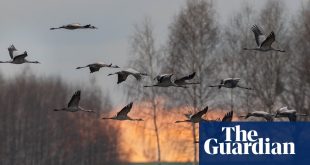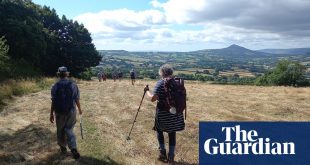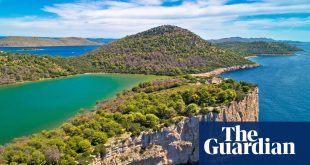In a clearing at the foot of the Bavarian Alps, a stoat breaks cover. The little creature flows quickly across the grass, its eyes set ahead, the ice white of its fur broken only by the black tip of its tail. The dazzle of its winter coat provides zero camouflage on this cold, mid-January morning – all the snow is further up the slopes – but its button nose and exquisite colouring are a vision all the same, a cartoon come to life in Germany’s far south.
The stoat isn’t the only thing to have fallen from a Disney animation. Minutes away, set against a frost-dusted cragscape of dark peaks, a hilltop palace spears into the sky. It is spectacular and preposterous, an ivory fortress that seems to have been formed in a dream. Turrets zoom up towards the clouds, asymmetric balconies gaze out across the land, statues of knights stand on pinnacles. This is Neuschwanstein Castle – the most flamboyant of many such creations here in the hills – and the story behind it is every bit as bonkers as its design.
I’ve come to the Allgäu region in southern Bavaria, by rail, on a newly launched winter getaway. It’s a trip with various selling points, including rollercoaster mountains and a hotel that ranks as one of the greenest in the country. Another boon is the quiet of the season. The destination attracts hordes of summer visitors, most of them drawn by the old-world towns and castles. Far fewer people come calling in winter, when the area’s lakes and pinewoods are hushed and the historic sights are at their most imposing. The cliches of rural Bavaria, meanwhile – frothing beers, unironic dirndls, log stacks outside the windows – are here year-round. Is there a German word for the sense of smugness you get from being somewhere special off-season? Probably.
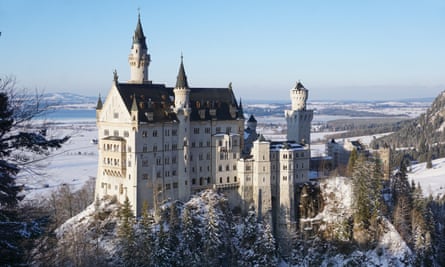
“The king found the public annoying,” says my guide, Walter, as I’m led through Neuschwanstein’s opulent interior. He’s talking about King Ludwig II, the starry-eyed monarch who commissioned the castle in the mid-19th century. “He adored opera, but hated people coming along to stare at him. So he arranged his own private concerts: 209 of them, to be precise.” We stop outside a room modelled to resemble a dripstone cave, complete with stalactites and rocky walls. “He had some interesting ideas, as you see.”
Ludwig’s face now adorns tankards and mouse mats in all the local gift shops, but his tale is a sad one. A lonely, romantic child, he became the teenage king of what was then an independent Bavaria in 1864. The kingdom soon became part of the new German empire, leaving him with few responsibilities. So he retreated into a world of lavish fantasy, spending eye-watering amounts on faux-medieval palaces. The building of Neuschwanstein was a step too far. Ludwig was declared incurably insane, deposed, then found drowned in a lake. The castle – which, despite its size, has a dining table big enough for just two – has been a museum ever since.
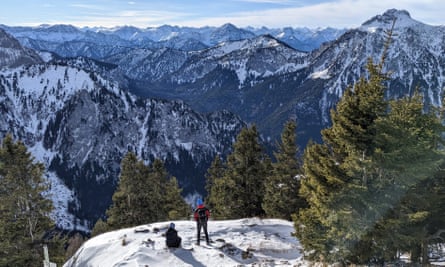
His story finds a natural home in the Allgäu, where the scenery has a twisted fairytale quality of its own. The meadows of the Bavarian countryside are lush and low-lying, dotted with wooden farmsteads. But as they stretch south, something bizarre happens. Just beyond the area’s main settlement of Füssen – originally Roman, later a wealthy trading post, these days a historic town full of bars and restaurants – the fields become mountains. Just like that. There’s no gradual buckling of the land. It’s grassy pastures one moment, and the fearsome inclines of the Alps the next. “Like a wall,” one local says to me, smiling. “A big one.”
In geological terms, this equivalent of the volume being cranked from one to 10 makes for some fine walking. The trip I’m sampling has no set itinerary – it’s been designed as a winter break for non-skiers – so I choose to spend much of my time on foot. The sparse mid-January snowfall means I can’t give snowshoeing a bash (though it’s what visitors on snowier trips would no doubt be doing), but the hiking paths are plentiful. Trailheads are reached by bus, and the routes themselves are generally either pancake-flat trundles or hilly ascents.
I try one of the latter, a long yomp through squirrelly pines to cross the dragon-back Zirmgrat ridge. Cliffs tumble into the valleym unseen woodpeckers drum in the trees and the peaks of Austria are visible beyond. I extend the walk for a couple of hours to head down throughwoods to Füssen, stopping at a cafe terrace by a half-frozen lake. When my beer arrives – a dark, rich dunkel – the server lays a heavy sheepskin over my knees as a matter of course.
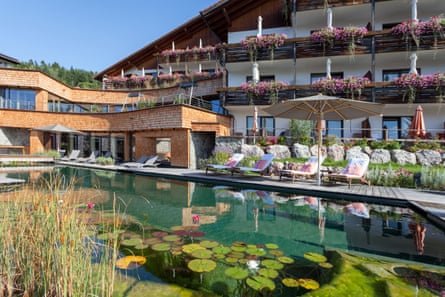
My base for the trip is the remarkable Biohotel Eggensberger, in the village of Hopfen-am-See, about 10 minutes outside Füssen. Fully organic since 2001 and now 100% climate-neutral – thanks to solar panels, hydroelectricity and a biogas made from food waste – the hotel has a converted VW Beetle engine in the basement producing power from biogas, a wellness centre with herbal steam showers, and a garage full of e-bikes and e-cars. “When we first went organic we had to keep it a secret,” laughs hotel owner Andreas Eggensberger, who doubles as a physiotherapist. “Back then, people would assume we were a kind of monastery, with only green food.”
This is emphatically not the case. Sporty septuagenarians with glowing skin wander the corridors, fuelled by a buffet of local goodies. The hotel has various other laudable policies in place. Among them is the way any guest arriving by rail – which, by combining Eurostar with long-distance trains through France (or Belgium) and Germany, means London to Füssen is doable in a day – is picked up and dropped off for free. And, brilliantly, anyone who opts not to have their room cleaned on any given morning is given a €5 drinks voucher. My duvet stays ruffled throughout.
Back to the outdoors. One morning I make a slow loop around the Hopfensee. The surface of the lake is a breeze-ruffled blue and the shoreline is clustered with evergreens. Distant bells peal out from an onion-domed church. Both the lake and the tall, shaggy spruce trees are full of birds familiar from home – wrens, coal tits, tufted ducks but when I look at their German names they feel like strangers: Zaunkönig, Kohlemeise, Reiherente. I linger over coffee and chocolate cake halfway round, not really wanting the walk to end.
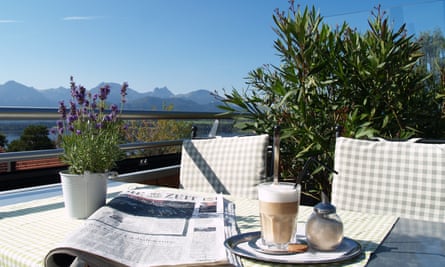
On my final day I hire an e-bike and spend hours scooting around the countryside. The highlight comes when I park below the hulking peak of Tegelberg and catch a cable car to a height of 1,730 metres. Neuschwanstein is visible in the distance on the way up, its turrets tiny, like a kitschy cake-topper. At the top, I crunch through patchy snow and find a perch overlooking the mountains. In the freezing air, summits romp off into the distance. I stay there for ages, thumping my gloves together to stay warm. St Pancras station feels a long way away.
Which, of course, it is. Once I get back to the UK, an email drops into my inbox telling me that the season’s snow has arrived in force. Such is life. But somewhere at the foot of the Bavarian Alps there’s a castle that now looks even more fantastical, and a stoat in a white coat that feels right at home.
The trip was provided by Inntravel, which has seven nights half-board at Biohotel Eggensberger, with light lunch, return rail travel from London and walking notes and maps from £1,550pp, available until 26 March 2023. Travel to Paris was provided by Eurostar: London St Pancras to Paris Gare du Nord costs from £39. For more information on the Füssen area, visit en.fuessen.de
 Top Naija News: Nigerian News, Breaking News Nigeria and World News Top Naija News is a daily news publication in Nigeria, delivering the latest breaking news in Nigeria and around the world.
Top Naija News: Nigerian News, Breaking News Nigeria and World News Top Naija News is a daily news publication in Nigeria, delivering the latest breaking news in Nigeria and around the world.
